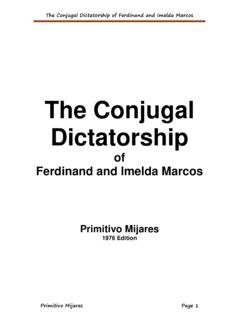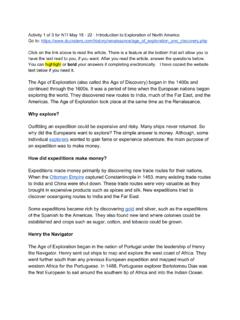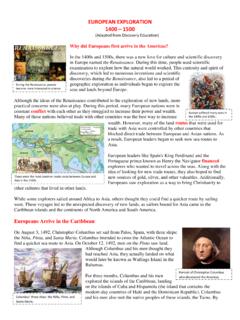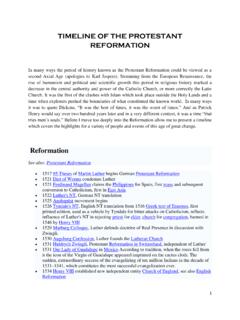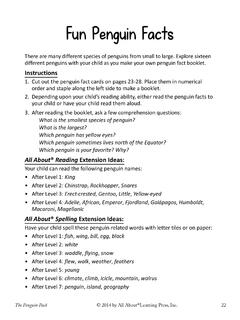Transcription of THE PERIOD OF RENAISSANCE IN ENGLISH LITERATURE - TPU
1 И.В. ГРЕДИНАTHE PERIOD OFRENAISSANCE INENGLISH LITERATUREУЧЕБНОЕ ПОСОБИЕ4 UNIT I. THE RENAISSANCE1485-1649 RENAISSANCE means re-birth. From about 1500 to 1600 the world wasreborn in many ways. The RENAISSANCE began in Italy, especially in art andarchitecture, in the fifteenth century. As England became the most powerfulnation in Europe in the late sixteenth century, new worlds were discoveredand new ways of seeing and thinking developed. Columbus discoveredAmerica in 1492, Copernicus and Galileo made important discoveries aboutthe stars and planets, ferdinand magellan sailed all round the world.
2 TheRenaissance was BACKGROUNDIn England there was an important change in religion and politics whenKing Henry VIII made himself the head of the Church of England, bringingchurch and state together (1529-39). He cut all contact with Catholic Churchand the Pope in Rome, part of a reaction against the Catholic Church in manyparts of Europe. Protestantism became more and more important and gave awhole new vision of man s relations with God. The king or queen became thehuman being on earth who was closest to God, at the head of the Great Chainof Being which led down to the rest of mankind, animals, insects and so Dutch thinker, Erasmus, wrote of mankind as central to the world, andthis humanist concern was the basis of most RENAISSANCE Tudors inherited much of the medieval view of the world whichconsisted of numberless but linked degrees of being, from the four physicalelements ( air, fire, earth and water)
3 Up to the pure intelligence of , the whole universe was governed by divine will; Nature was God sinstrument, the social hierarchy a product of Nature. Everything had theirnatural place in the unity of the whole: both within the family and state (whichit is believed, should be governed by a single head). At the same time, thisorder, which was founded on Nature, existed for man s benefit, and man wasan integral part of it. His godlike qualities had, unfortunately been ruined bythe Fall (as described in the Bible) and he was constantly troubled by suchthings as wars and plaques.
4 Nevertheless, provided that he treated this worldas preparation for the next, and, with the help of human reason, he kept hisbody subject to his soul; he had it within his powers to enjoy of Henry VIII and Anne Boleyn, Queen Elisabeth(1533-1603),became the symbol of the Golden Age, the PERIOD of stability from 1558 to1603. Following her mother s execution, Elizabeth was declared illegitimateby parliament (1537), and suffered a lonely childhood, much of it spent in thecompany of her young brother Edward.
5 She was rigorously educated, studying5 Latin and Greek. The accession of her sister as Mary I in 1553 increased theinsecurity of Elizabeth s position, she was an opponent of religiousextremism, she was seen as natural focus for the protestant faction. Accusedof involvement in Sir Thomas Wyatt s rebellion, she was imprisoned in Towerbefore being placed under house arrest at Woodstock (1554).At her accession in 1558 Elizabeth inherited a nation deeply divided byreligious strife. She set about restoring the moderate Anglicanism of herfather: Mary's grants to the Roman Catholic orders were reclaimed; theAnglican service was reintroduced (1559).
6 Economic reforms included thecalling in of the debased coinage of the previous three reigns. Elizabethappointed as her chief secretary William Cecil, who remained her trustedadvisor and friend until his death in 1598. Parliament, anxious to secure theProtestant succession, urged her to marry but she refused, although throughouther reign she used marriage as a diplomatic counter in her relations withFrance. She conducted romantic relationships with a number of men, forexample, with Robert Devereux, earl of prudent financially as she was cautious diplomatically, Elizabethfinanced government from her own revenues and called Parliament to votesupplies only 13 times during her reign.
7 Her management of Parliament wasmarked by a willingness to compromise and demonstrated a political skilllacking in her Stuart successors. By her evident devotion to the welfare of hersubjects, she helped create a national self-confidence that bore fruit in the last15 years of her reign, notably in LITERATURE and in the works of such writers asMarlowe, Spencer and the last monarch of the House of Tudor, Elizabeth was a Protestant(a term used for those who broke away from the Roman Catholic Church).Her predecessor, Mary I (on the throne 1553-1558), had been a repressiveCatholic, married to the most fanatically Catholic sovereign in Europe, PhilipII of Spain).
8 Although Elizabeth cut the ties with Rome, her tolerance and herability to compromise won her the loyalty of both Catholic and Puritans(Protestant reformers who insisted on simplicity in religious forms). In 1588 Philip s attempt to conquer England led to the defeat of great Spanish fleetknown as the Armada. Sir Francis Drake (1540-1596), a national hero, wasone of the commanders of the ENGLISH fleet. This victory was a great triumphfor Elizabeth and through her nation. England s enemies, Spain in particular,were defeated, and the ENGLISH controlled the seas of the world, exploring andbringing valuable goods from the New World.
9 This was closely linked withthe RENAISSANCE search for new ways of believing, new ways of seen andunderstanding the RENAISSANCE was the beginning of the modern world in the areas ofgeography, science, politics, religion, society and art. London became not6only the capital of England, but also the main city of the known world. AndEnglish, in the hands of writers like Shakespeare, became the modernlanguage we can recognize today. The invention of printing meant that allkinds of writing were open to anyone who could read.
10 Many new forms ofwriting were developed. But the most important form of expression wastheatre. This was the age of Shakespeare, and the Golden Age of can distinguish three periods of LITERATURE of ENGLISH RENAISSANCE . Thefirst PERIOD covers the end of the 15th and the first half of the 16th centuries. InEngland the first scholars and humanists appeared, they studied andinvestigated the antique philosophy, LITERATURE . In Oxford and CambridgeUniversities the first generations of the ENGLISH humanists were trained, thedevelopment of the book printing was of importance for humanistic first ENGLISH printer William Caxton (1422-1491) learnt the art of printingat Cologne in the early 1470-s (Guttenberg in Germany in 1440).




